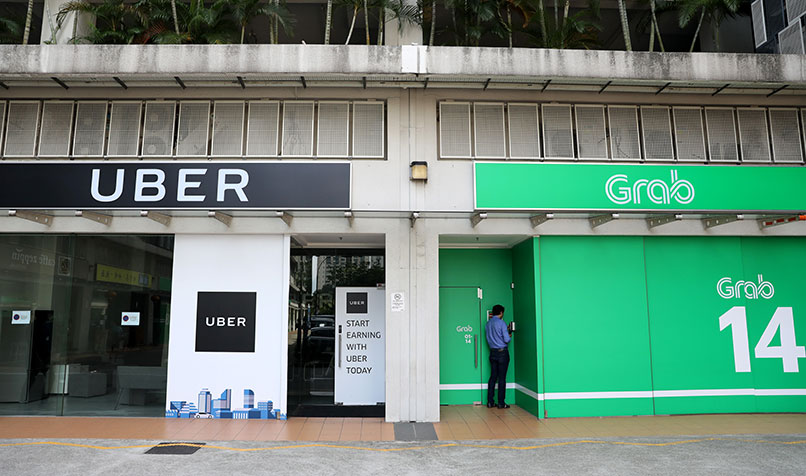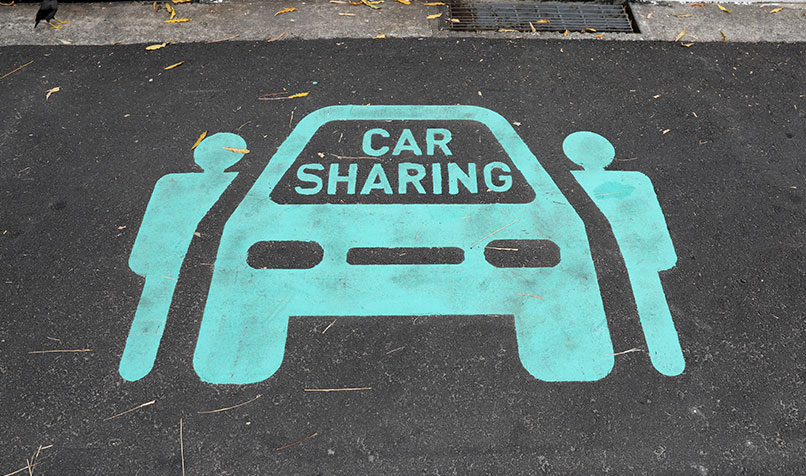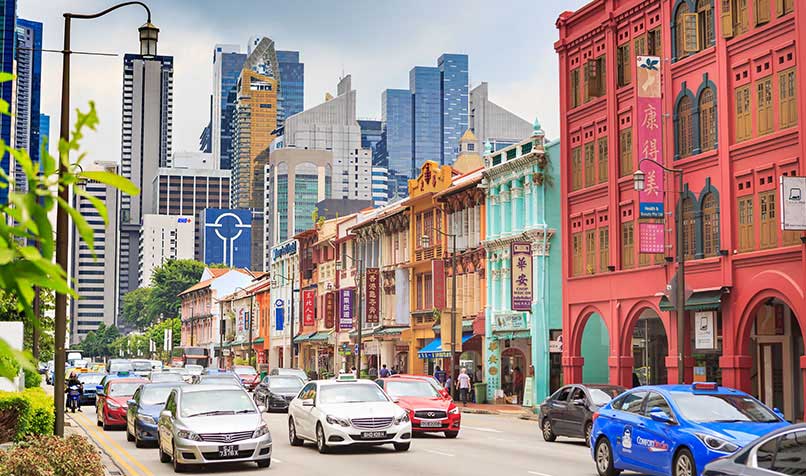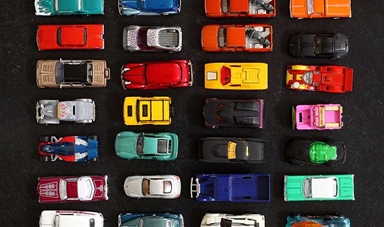Loading component...
At a glance
By James Dunn
The sharing economy – or “shareconomy” – is loosely defined as an economy built on sharing, swapping, trading or renting products and services using online platforms: think Uber, Taxify and Airbnb. It generates economic activity by enabling people to share and earn income from underused assets such as cars, apartments and tools – and city-state Singapore is an early adopter.
“Singapore boasts a diverse range of goods and services being traded on these platforms – grocery delivery, booking vacation homes and workspaces, peer-to-peer lending, and matching professionals with hiring companies, to name a few,” says Selena Ling, head of treasury research and strategy at OCBC Bank in Singapore.

“The success of the shareconomy in Singapore is evident with the widespread popularity of Airbnb [peer-to-peer accommodation rentals], Grab [ride sharing, similar to Uber], as well as local businesses such as PandaBed [vacation home sharing], Vanitee [beauty services sharing] and iCarsClub [car sharing] taking off.
"While it’s logical to monetise the items we rarely use, this was not possible until a few years ago when technological advancement and the prevalence of digital devices made it feasible.”
Ling says Singapore “essentially fits the cut” on most of what are usually considered the key drivers of a sharing economy – modern information and communication technology (ICT) infrastructure and usage, demographics, tourism, consumer preferences, and government support.
“Singapore has the highest percentage of individuals using the internet in South-East Asia [84 per cent],” according to Ling.
“Apart from developing 5G networks and the Internet of Things [IoT], the government has been actively working with the private sector to support the development of IT, particularly in the mobile e-payments sector. Singapore continues to be ranked globally among the top countries in terms of digital readiness and competitiveness, including the World Economic Forum’s NRI [Networked Readiness Index (also referred to as Technology Readiness)]."
High internet and mobile social media penetration are crucial, agrees PwC Singapore transport and logistics leader Elaine Ng.
“With ready access to sharing apps and with cheaper and more efficient options at their fingertips, it is therefore little wonder that Singaporeans have so readily taken to the shareconomy," Ng says.
Word of mouth drives growth of Singapore's sharing economy

There is also an element of the chicken and egg dilemma, in that the concept of the shareconomy is more easily understood by using it, says Jim Tan, squad leader and growth manager at Skyscanner and president of the Sharing Economy Association of Singapore (SEAS).
“Until recently, most Singaporeans weren’t very sure what the sharing economy meant,” Tan says.
“But with Uber, Grab, Airbnb and many other sharing businesses building their presence in Singapore and abroad, they have built a decent [market] in terms of users and suppliers. Most people have used them and feel that they bring convenience to their daily life.”
In March, Uber and regional rival Grab merged, with the former ceding to Grab in many South-East Asian countries, including Singapore, Malaysia, the Philippines, Thailand, Vietnam, Cambodia, and Myanmar.
“Singapore has a dense population, and matching demand with supply is always a challenge,” Tan says. “With high-speed internet, mobile adoption, credit card and digital payment penetration, the digital ecosystem is a factor that allows the shareconomy to bloom.”
It has definitely changed consumer behaviours, he adds, but the economic and social impact is just as profound on suppliers.
“Many retired homeowners use Airbnb to subsidise their retirement. In the cases of Grab and the sharing delivery companies, many people use these platforms to subsidise their cost of living.”
Rent or own?
Demographic trends are another impetus for the shareconomy – in particular, the transition to adulthood of millennials (Gen Y) born between the early 1980s and early 2000s.
“Post-GFC [global financial crisis], there may have been a rethink of attitudes towards consuming goods and services, with a preference for more collaborative consumption that results in less wastage so as to ensure a more sustainable model,” Ling says.
“Millennials also like the work-life balance in the ‘gig economy’, which allows freelancers to participate in some areas of the shareconomy.”
Of course, millennials may also be more willing to consider sharing things because they cannot afford to buy them outright.
“The economic aspect is important for the large take-up rate of the shareconomy among millennials,” Ling explains. “Due to the attainability gap in housing and cars, young people may be less willing to resort to debt financing.
"Until recently, most Singaporeans weren’t even sure what the sharing economy meant.”
“Data from Goldman Sachs and PwC also indicates that purchasing and owning a house are no longer realistic aspirations for the majority of millennials. There appears to be a growing disconnect between house prices and earnings growth, as well as a shift in attitudes towards owning property, and possibly other big-ticket items.”
Faced with what they see as an inability to buy houses and cars, Ling adds that millennials have become the heaviest users of shareconomy platforms such as Airbnb, Uber and car2go, the world’s largest and fastest-growing one-way car sharing service (a subsidiary of German automotive corporation Daimler AG).
Ling says close to one-quarter (23.8 per cent) of millennials surveyed by research firm Verdict are not concerned with owning a home and would be content to rent for life; while 57 per cent of adults agree that access [to accommodation] is the “new ownership”, according to PwC.
“However, the shift in attitude could also largely be a consequence of the availability and affordability of shareconomy platforms,” Ling maintains. “Within South-East Asia, travellers in Singapore are among the most avid users of Airbnb’s outbound travel services. However, for now domestic home ownership remains highly coveted amid rising private residential property prices in Singapore.”
Singapore's sharing economy winners and losers

Nonetheless, adoption of Airbnb in Singapore has been hampered by the country’s laws: private homes in Singapore are subject to a minimum rental period of three consecutive months. Two Airbnb hosts were individually fined S$60,000 in April for unauthorised short-term letting. As part of a consultation process, the government has now proposed to allow homeowners to lease their property on a short-term basis, but with an annual cap of 90 days a year – similar to measures introduced in other cities such as Paris, London and Amsterdam.
Transport in particular has been fertile ground for Singapore’s shareconomy, with bike sharing services such as Mobikes, Ofo Bikes and LimeBikes taking off, and car and van sharing services such as Grab, iCarsClub and GoGoVan following suit.
“Singaporeans from all walks of life have embraced the use of bikes to travel short distances and have found it particularly helpful to bike from home or the office to the nearest public transport amenity and vice versa – the ‘last mile connectivity’ that is important in making public transport a mode of choice when compared to the private car,” Ng says.
“Singapore’s climate is generally hot all year round, and [push] bikes offer a quicker option than walking from point-to-point under the sweltering sun.”
Also, housing in Singapore is generally high-density, meaning most residents do not have their own parking or storage facilities for bikes, so “using shared infrastructure is more efficient and attractive,” Ng says.
Hailing a ride in Singapore
This is even more pertinent when it comes to sharing cars, because Singapore rations car ownership. In February 2018, it imposed a zero growth rate on private motor vehicle ownership; residents already have to bid for the right to own and use a car for a set number of years. While the city-state improves public transport infrastructure, the sharing economy is helping to meet the population’s current needs, before the government assesses car ownership levels in 2020.
“In Singapore, it is very costly to own a private car,” Ng says. “When you consider the cost of acquiring a Certificate of Entitlement [COE], the price of purchasing the car, loan instalments, expensive parking fees in the city and the electronic road pricing charges to enter certain zones during peak hours, it really all adds up. For some of the higher marques, you could buy a nice house in some suburbs in Australia.”
"The economic aspect is important for the large take-up rate of the shareconomy among millennials.”
When ride hailing apps came to Singapore, many car owners signed up to become drivers as a means to earn extra money and defray the cost of car ownership.
“On the other hand, passengers were happier with the increased and wider choices of transport options and at more competitive pricing as the platforms fought aggressively for market share,” Ng says.
Tan believes Singapore’s compactness makes it perfect for ride sharing. “It works really well in a [metropolis] such as Singapore for a range of reasons,” Tan explains.
“It’s a better match of demand and supply, using data. It’s more fuel-efficient for drivers, compared with the traditional method of cab drivers roaming around looking for customers.
It’s a service-oriented ecosystem, with transparent pricing, ETA [estimated time of arrival] and the rating after the trip, and very accurate Google Maps navigation, which saves time and provides more accurate info for drivers and passengers.”
Here to stay: Singapore's sharing economy

Ng believes the sharing economy is “here to stay” in Singapore, not only because it has win-win elements for consumers and providers, but because it ties in with the government’s drive to promote collaboration between the public and private sectors to harness and adopt digital technologies throughout Singapore.
“The Singapore Government has been at the forefront of driving digital transformation towards ‘Smart Nation’, which is Singapore’s vision to be an economically competitive global city and liveable home,” Ng says.
“Rather than fear disruptive technologies, Prime Minister Lee Hsien Loong [in a recent May Day Rally speech] called on workers to remain relevant by re-skilling, and to view such changes as positive and to embrace them.
"For example, the Land Transport Authority (LTA) is supporting the launch of a new app in 2018, Whim, which aggregates all public transport modes in one app and can enable commuters to understand the quickest and easiest ways to travel from one place to another using public transport. It offers various pricing plans that include a monthly subscription that covers all forms of public transport. It is just one of the initiatives that will further Singapore’s push to be a ‘car-lite’ society.”
Ling also sees “dialogue and engagement” between the government and the shareconomy emanating from the Smart Nation thrust.
“We see a lot of overlap between these shareconomy start-ups and the government’s social initiatives and social enterprises,” she says.
“For example, GrabShuttle (Grab’s minivan and bus booking app) collaborates with Beeline, a transportation platform using real-time data created by Singapore’s Government Technology Agency (GovTech), to provide multi-passenger transport on demand and, in a way, mimic a bus service.”
Beeline bus routes are adaptive, meaning new routes are activated based on commuter demand, and existing routes may evolve over time. It enables private bus operators to provide optimised shuttle bus services and use data analysis tools for fleet management and operations. There are currently nine private bus operators on Beeline, more than 150 drivers and 200 Beeline routes.
From his viewpoint as SEAS president, Tan knows that interest in the shareconomy is burgeoning. Four years ago, the association had six member organisations – now there is 35.
“Using data to optimise demand and supply and solve problems works really well here,” Tan declares.
“With the government pushing the Smart Nation vision, we expect to see more entrepreneurs and more start-ups in the shareconomy.”

